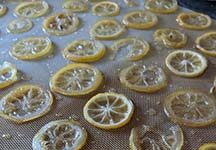Amanda Miller
Columnist
Lettuce Eat Local
The first time I asked the question, most of the kids raised their hands excitedly. “Ooh, me, me!” Wait a minute…I could see our kindergarten and first-grade class needed me to rephrase the question. While I didn’t know all their personal histories, I was pretty sure none of them had died and come alive again.
After explaining being born and alive now wasn’t what I meant, with the second try I could see the understanding sweeping across their intent little faces. None of them had “gotten not dead” before — no one can do that!
No one, of course, except Jesus, which is what I was getting at. Life itself is a miracle, but life again after dying is crazy. It’s tricky to know how to talk about death with such young kids, especially kids that are not mine, yet it’s also impossible to talk about Easter’s new life without death in the picture. We had a very quick, surface discussion in our kids’ class that night — I think they could sense that there were plastic eggs with candy yet to find — just a sentence or two about how seeds have to die to grow and eggs have to break for chicks to hatch, but what I hope they understood and remember for now is that Easter means Jesus loves them.
My consideration of the intertwining of death and life within Easter is a bit more nuanced of course, and I’m thinking about it in some special ways this year. We made a quick trip to Ohio this week, needing the rest of the family to meet new baby Kiah and for us to meet an even newer baby niece. These sweet tiny babies stand (or rather, are held) in contrast to the other person for whom we needed to visit Ohio: my 97-year-old grandpa. He’s on the other spectrum of this thing we call life, the babies with only a short span of days under their belts (/diapers) and Grandpa with only a short span of his long life left.
I also can’t be around Grandpa without thinking of Grandma, whose birthday is this week and who’s been gone for almost eight years. She died on April 12, the day before my birthday, and so forever her death and my birth are on the calendar close to Easter. Now I bring my baby girl, and forever I have that pang of sweet sorrow knowing Kiah and Grandma would have adored each other if they’d gotten the chance. Life and death, intertwined.
Mom had the beautiful idea of making Grandma’s famous Danish pastries while we were together, a tangible and literally sweet way of remembering her. While four-month-old Kiah was much more interested in sleeping than helping, it did feel like we had four generations of mothers and daughters working together. It was a much longer process than we had anticipated, realizing after we actually read the recipe that these signature knots are essentially frosted croissants; it was another sweet glimpse into the life of my grandma who didn’t love to cook but invested so much time and effort into making these precious pastries for the people around her. She was a quiet woman, yet she loved so well.
I swung by her grave real quick as we left church on Sunday. I know she won’t “get not dead” and that I won’t see her here again, no matter how many Danish pastries I make in her honor. But I’m not so sad, because like we tell Benson, she just didn’t need her body anymore. She gets to be with Jesus now, the One who did rise again, the One we really remember every Easter with death and life intertwined.
Grandma Mayer’s Danish Pastries (greatly abbreviated version)
These are a bit of a legend around here, and for good reason. I remember seeing these caramel-frosted knots filling up Grandma’s table as she finished them, and arranged in Tupperwares and on paper plates to keep eating and to give away. I had no idea they were so much work — I’ve made laminated dough before, but I think only once, because it was A Thing. Fortunately, that experience already in my repertoire greatly assisted my experience following Grandma’s recipe, which was definitely not what I would call overly complete (it reminds me of the technical round in the Great British Baking Show, if that tells you anything). It’d be much too long for this column if I rewrote it in a more helpful fashion, so look up homemade puff pastry if you want to start from scratch for yours. It felt like a shame to frost such incredibly layered, flaky pastries, but they did go from amazing to phenomenal, at least with our attached memories.
Prep tips: Grandma’s recipe said “shape as desired,” but this is how Mom and I remember them looking. Honestly, we think she might have used margarine in her pastry dough (it was the era for it) because ours baked up so much flakier and possibly even tastier than we remembered.
a batch or package of puff pastry dough, cold
1 cup light brown sugar
5 tablespoons salted butter
½ teaspoon salt
¼ cup whole milk
1 ½ cups powdered sugar
a splash of vanilla or maple flavoring
Cut pastry into strips approximately 6”x1”x ½”. Roll like a rope and shape into a pretzel-ish knot. Bake as directed; let cool fully (eat some hot). Mix and melt the brown sugar, butter, and salt together, then add milk and bring to a boil. Cook and stir for a couple minutes, then let cool slightly. Whisk in powdered sugar and vanilla to spreading consistency, and frost the pastries.



